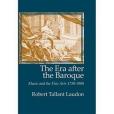《The Era After the Baroque》是一本圖書,作者是Laudon, Robert Tallant
基本介紹
- 外文名:The Era After the Baroque
- 作者:Laudon, Robert Tallant
- 出版時間:2008年4月17日
- 頁數:100 頁
- ISBN:9781576471241
- 定價:28.00 美元
內容簡介
What shall we call the era in Western music history from 1750 to 1900? Listeners and scholars alike treasure the works of its great composers: Mozart, Beethoven, Chopin, Wagner, Tchaikovsky. A powerfully symbolic name, though analogous to "baroque" for the previous era still eludes us. We refer constantly to two trends, classical and romantic, which have substantive meaning for...(展開全部) What shall we call the era in Western music history from 1750 to 1900? Listeners and scholars alike treasure the works of its great composers: Mozart, Beethoven, Chopin, Wagner, Tchaikovsky. A powerfully symbolic name, though analogous to "baroque" for the previous era still eludes us. We refer constantly to two trends, classical and romantic, which have substantive meaning for various composers' orientations and for ways of performing the music. But these two terms whether understood as indicating consecutive or overlapping trends do not plainly suggest the two main events of the age: the Industrial Revolution, and the democratic political upheavals of 1776, 1789, and 1848. Also, they do not acknowledge an emerging sense of humanity or the excitement of a passionate audience seeking recognition and expression. Laudon's Era after the Baroque proposes a powerful symbol for the new era while at the same time keeping traditional terminology intact. It looks at the age in a primarily positive manner while still acknowledging its darker aspects. In particular, it evokes the sphere of the newly recognized system of "fine arts" and therefore has resonances for the visual and literary arts in addition to its primary focus on music. The Era After the Baroque advances an expressive ideal that is traced in both vocal and instrumental music during that century and a half. It stresses that music was not an art unique and set apart but rather participated in the great dissemination of education and artistic opportunity that was then emerging in the context of an incr

